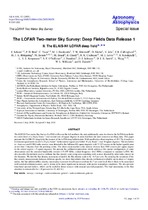| dc.contributor.author | Jarvis, Michael. J | |
| dc.contributor.author | Sabater, J | |
| dc.contributor.author | Best, P.N | |
| dc.date.accessioned | 2021-04-28T12:04:26Z | |
| dc.date.available | 2021-04-28T12:04:26Z | |
| dc.date.issued | 2021 | |
| dc.identifier.citation | Jarvis, Michael. J. et al. (2021). The lofar two-meter sky survey: Deep fields data release 1: II. The elais-n1 lofar deep field. Astronomy and Astrophysics ,648,A6 | en_US |
| dc.identifier.issn | 0004-6361 | |
| dc.identifier.uri | 10.1051/0004-6361/202038828 | |
| dc.identifier.uri | http://hdl.handle.net/10566/6106 | |
| dc.description.abstract | The LOFAR Two-metre Sky Survey (LoTSS) will cover the full northern sky and, additionally, aims to observe the LoTSS deep fields to a noise level of ? 10 μJy beam-1 over several tens of square degrees in areas that have the most extensive ancillary data. This paper presents the ELAIS-N1 deep field, the deepest of the LoTSS deep fields to date. With an effective observing time of 163.7 h, it reaches a root mean square noise level of ? 20 μJy beam-1 in the central region (and below 30 μJy beam-1 over 10 square degrees). The resolution is ~6 arcsecs and 84 862 radio sources were detected in the full area (68 square degrees) with 74 127 sources in the highest quality area at less than 3 degrees from the pointing centre. The observation reaches a sky density of more than 5000 sources per square degree in the central region (~5 square degrees). We present the calibration procedure, which addresses the special configuration of some observations and the extended bandwidth covered (115-177 MHz; central frequency 146.2 MHz) compared to standard LoTSS. We also describe the methods used to calibrate the flux density scale using cross-matching with sources detected by other radio surveys in the literature. We find the flux density uncertainty related to the flux density scale to be ~6.5 per cent. By studying the variations of the flux density measurements between different epochs, we show that relative flux density calibration is reliable out to about a 3 degree radius, but that additional flux density uncertainty is present for all sources at about the 3 per cent level; this is likely to be associated with residual calibration errors, and is shown to be more significant in datasets with poorer ionosphere conditions. | en_US |
| dc.language.iso | en | en_US |
| dc.publisher | EDP Sciences | en_US |
| dc.subject | Catalogs | en_US |
| dc.subject | Radio continuum: Galaxies | en_US |
| dc.subject | Radio continuum: General | en_US |
| dc.subject | Surveys | en_US |
| dc.title | The lofar two-meter sky survey: Deep fields data release 1: II. The elais-n1 lofar deep field | en_US |
| dc.type | Article | en_US |

